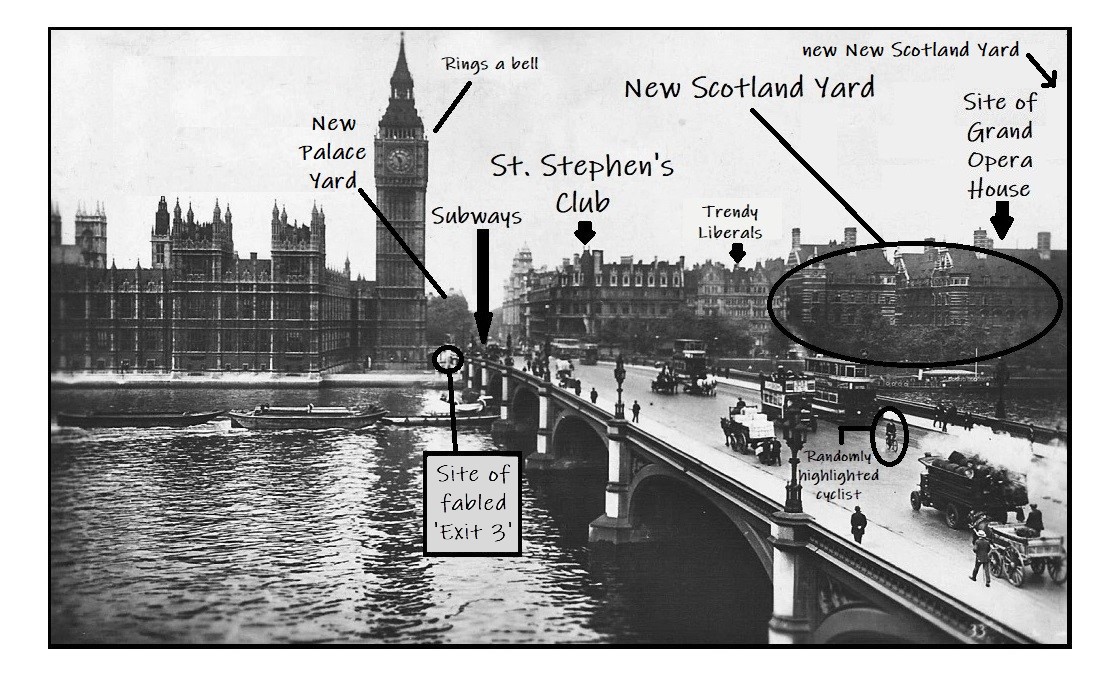
The building of the District Railway and the Victoria Embankment in the 1860s combined to produce an attractive riverside development opportunity just across the road from Parliament. This site would play host to a Conservative club that counted Oscar Wilde as a member, an opera house that would have been the largest in the world had it ever been finished, the original New Scotland Yard, political espionage, a foul murder and a curiously decorative subway.
The cut-and-cover technique for building underground railways involves following the line of roads, so avoiding the need to buy up and demolish buildings. At least in theory. In practice, constructing the Metropolitan and District railways caused havoc as hundreds of structures were torn down. One area hit was the riverfront at Westminster, where the eponymous station opened in 1868 amid a site laid waste by its creation. This desirable plot of land looked out over the new Victoria Embankment, Westminster Pier and Parliament’s famous clock tower. What’s more, the railway company had helpfully built a subway (US: underpass) under Bridge Street linking the station with New Palace Yard, convenient for MPs1 and in an unusually decorative style appropriate for an entrance to the neo-gothic Palace of Westminster. This was later joined by a more routine white-tiled subway to Embankment. Developers soon wanted a piece of the action, and the first to arrive was a political club.
A Conservative club to connect with the common man
The Reform Act of 1867 greatly increased the male electorate, which then showed rank ingratitude by throwing the Conservative Party out of government in an election the following year. The party needed to engage with the newly empowered lower classes, and the St. Stephen’s Club was formed in 1870. It was designed to be less exclusive than the major Tory club of the time, the Carlton, and convenient for MPs, party workers and like-minded individuals more in touch with the new voters.
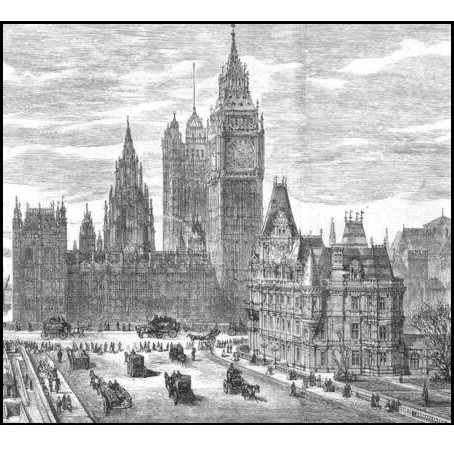
Seeking a permanent home, the club selected a prominant corner site next to Westminster station and immediately got into a fight with the Metropolitan Board of Works (‘MBW’). The MBW wanted to preserve an uninterupted view of the clock tower from Embankment, which would have forced the club to build further back, directly over the station. The site was already a difficult shape, so the club went to court, where it transpired the MBW didn’t have a legal leg to stand on.
The new clubhouse opened in 1875, and came close to shutting again six months later when it narrowly avoided incineration: A gas leak led to an explosion and fire in a sewer beneath the pavement, sending flames twelve feet high through a grating just outside the club, as if it had been built on top of hell.
← St. Stephen’s Club in 1875, showing the impaired view of the clock tower from Embankment.
I’ll return to the club shortly, but now it’s time for an operatic interlude.
Mr. Mapleson’s Magnificent Temple of Terpsichore
Also in 1875, work began on a ‘Grand Opera House’ on another part of the site, just a stone’s throw to the north. The brainchild of impresario James Mapleson, things went wrong from the start, investors’ confidence draining away mainly because water pouring into foundation trenches didn’t. The preliminary works ended up going £27,000 over budget – £2.5 million today. Somehow, additional funding was found for the colossal building to reach the height of the grand tier boxes before it became apparent to everyone except Mapleson that the sums didn’t add up. Work stopped, and the structure was abandoned until 1888 when he was declared bankrupt and the site sold for redevelopment. In a ghoulish turn of events, workmen demolishing the walls found the torso of an unknown woman in a box in the basement. The crime went unsolved, and attempts were made to link it to the famous Whitechapel murders. There was also a theory that an ‘arm’ found in Guildford was once connected to the torso, but it turned out to be a boiled bear’s foot imported and then discarded by a Russian man.
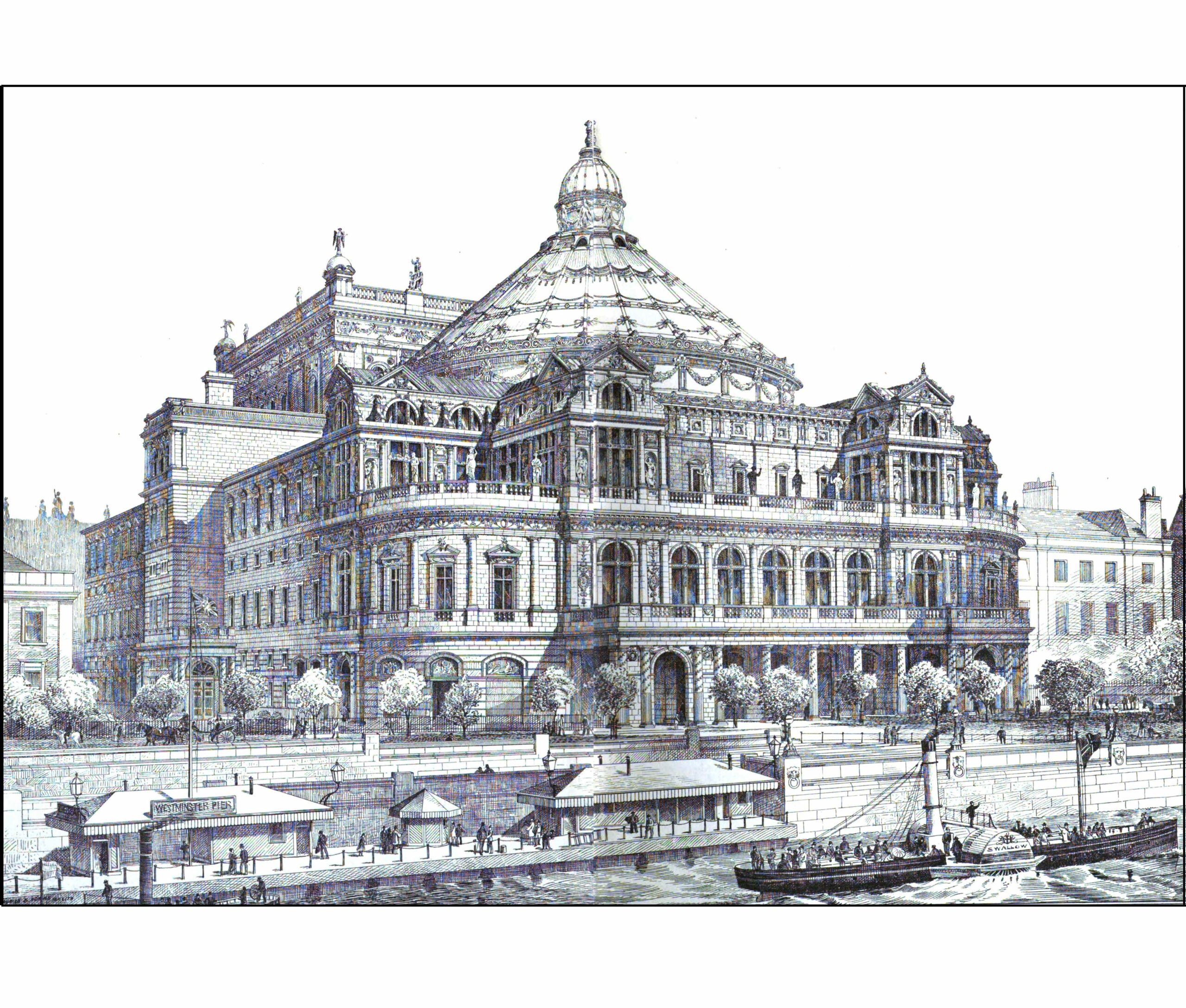
← The Grand Opera House would have dominated Embankment.
One of Mapleson’s more bizarre claims was that a division bell, if placed in the opera house, would have enabled MPs to get back to the Commons in time to vote. That was optimistic – the six minutes allowed for MPs to vote after the bell rang had to be extended to eight a century later when MPs moved into offices on the site.
‘ello ‘ello ‘ello … What’s all this then?
On the site of the ill-fated opera house rose New Scotland Yard, the iconic Metropolitan Police HQ designed by Norman Shaw. He reused the opera house foundations and basement, which he turned into cells. The prospect of criminals occupying what should have been opera singers’ dressing rooms outraged Mapleson, who must have been even more annoyed when the Met installed their ‘black museum’ of criminal memorabilia close by, near to where the murder victim’s torso had been found.
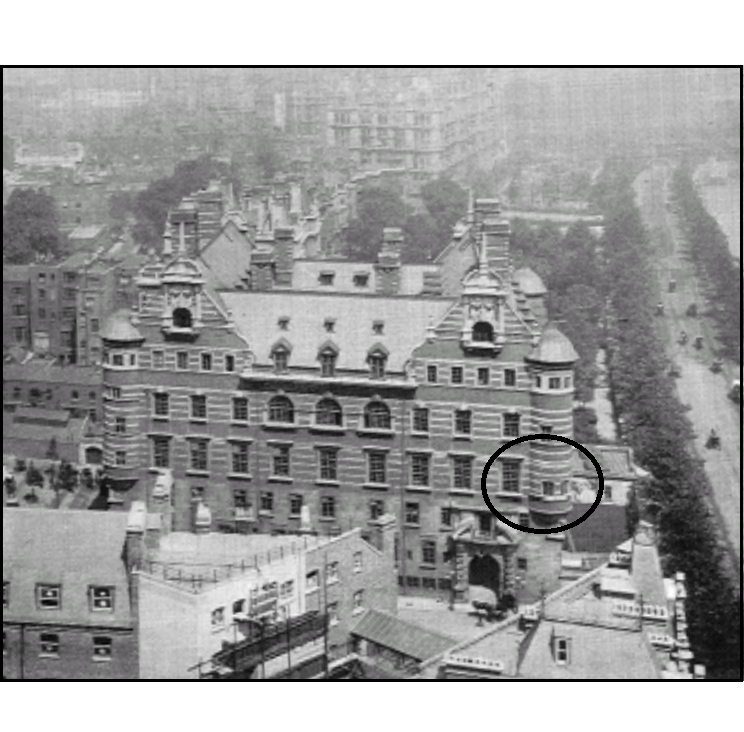
Opened in 1890 and now known as the Norman Shaw Building North, it has Classical, Dutch and Gothic influences and is widely admired. This wasn’t always the case, however. Initially it was seen as a ‘vulgar interuption’ in the view along Embankment, particularly as the attractive main façade wasn’t on Embankment at all, instead facing a side road, Derby Gate. Granite cut from quarries by convict labour at Dartmoor prison was used to reduce costs, but the elevations above the ground floor are an attractive mix of brick and Portland stone. A southern extension in the same style, now the Norman Shaw Building South, was opened in 1906 the other side of Derby Gate.
← New Scotland Yard shortly after opening, viewed from the clock tower. This main façade was later obscured by the 1906 extension. The Commissioner’s office is circled. Nearest the camera is St. Stephen’s House, an office block with a bridge over the railway connecting its two parts.
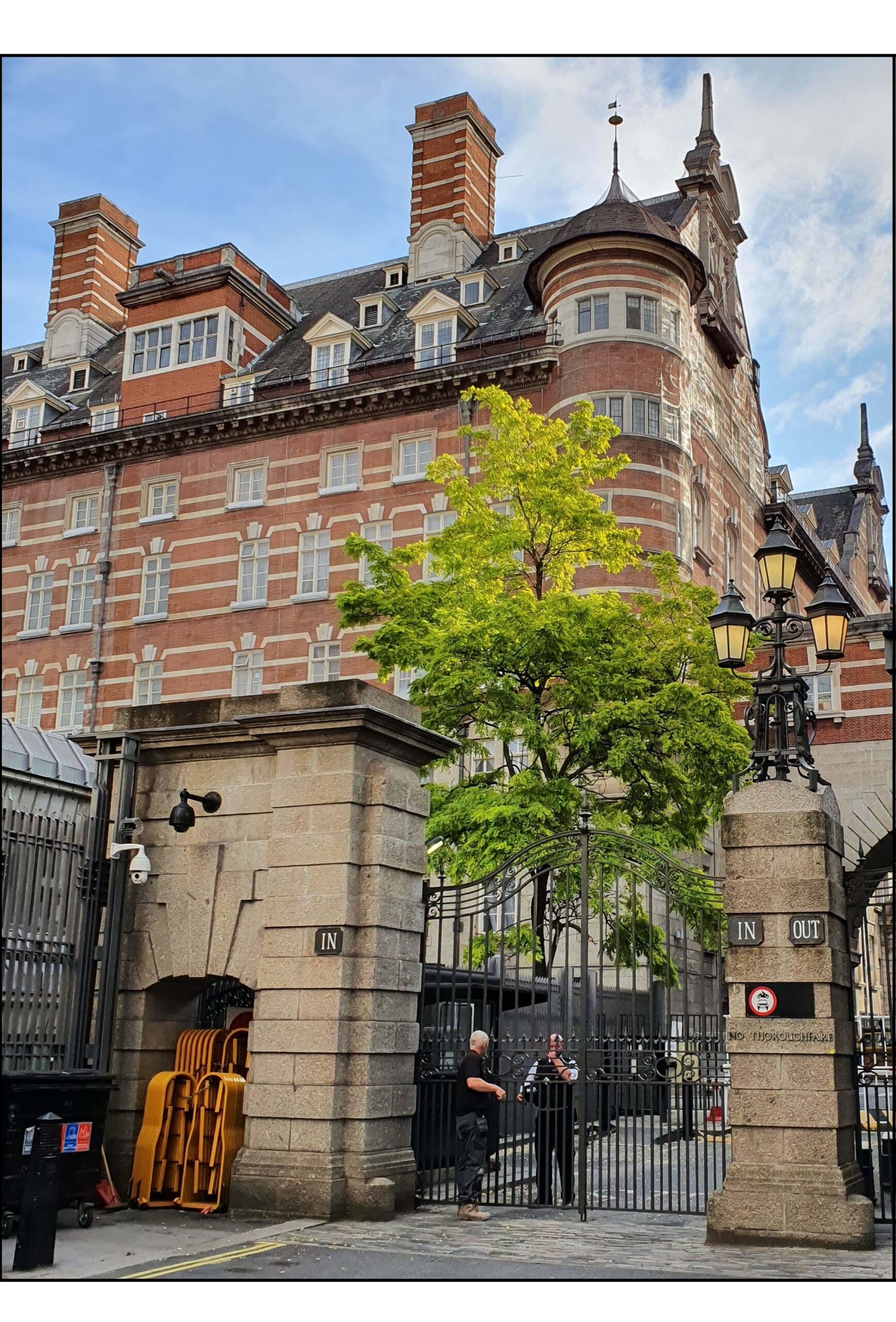
← Norman Shaw Building North in 2022, taken from Derby Gate looking east. The in/out signs appear in countless films as an establishing shot for scenes usually featuring a puzzled Scotland Yard police detective. The bridge to the right joins the original block to the 1906 extension over Derby Gate.
A subway between opera house and station completed by Mapleson was retained when New Scotland Yard was built, but closed when the North building was adapted as MPs’ accommodation in the early 1970s, and no doubt obliterated when the station was reconstructed in the 1990s.
Oscar Wilde and Truncated Octopuses
Returning to the St. Stephen’s, this was in many ways typical of a London gentlemen’s club. It was built of Portland stone in a confused style variously described as Classical, Palladian and French Renaissance. There was a well-equipped kitchen with a chef and two assistants, all French. There were billiard rooms, dining rooms, a smoking room, card room, reading room, library, morning room, grand spiral staircase and a wine cellar. Wood panelling, ornate fireplaces and marble all featured. Membership was open to men only. The architect was John Whichcord Jr., who went on to design the Grand Hotel in Brighton and stood unsuccessfully for Parliament as a Conservative.
So far, so conventional. But the design certainly had its quirks. A report on the unfinished structure in a trade journal in May 1874 took exception to much of the exterior, with detailing being ‘meagre’ and ‘too slight’, while peversely the overall impression was of a building ‘overdone and fussy’. The reporter particularly disliked the toy-like dormer (roof) windows, behind which – bizarrely – Whichcord had put the kitchen. The curious arrangements didn’t end there, the article stating that the interiors were ‘rather more peculiar than pleasing’. Whichcord’s attempts to keep important rooms a reasonable shape despite the site’s irregular dimensions had left others resembling a ‘truncated octopus’. The new club was damned in the House of Commons as ‘an ugly and objectionable building’, but then the House had wanted something more in keeping with the gothic revival style of Parliament itself.
The quirks continued with the membership. For some years from 1877, this included the far-from-Conservative Oscar Wilde. He was young, he needed a club; getting membership of this one was perhaps easier than most although his style of engagement with working class voters was probably not what the Tories had in mind when founding the club. There was also an extraordinarily high number of consulting engineers among members. Not a profession noted for passionate political views, they were nonetheless common in Westminster due to the myriad railway bills passing through Parliament.
To this list of oddities I must add the door leading from the basement to the public subway running between the station and Parliament’s New Palace Yard. The subway was created with Parliament’s blessing; the door perhaps not. It gave the Conservatives a significant political advantage. MPs could move between club and Parliament with ease, and the provision of a division bell2 gave them those six minutes to get to the lobbies to vote. It was just enough, but led to some strange behaviour.
Ambushes, sabotage and abandoned dinners
The Conservatives frequently exploited the bell in the early years. By hiding MPs in the club they could ambush opponents, who were lulled into a false sense of security by the apparent absence of the Tories. As a result they wouldn’t bother to warn all their MPs of an impending vote. The bell would ring and out of nowhere, Tory hoards would appear from the subway into New Palace Yard. Probably the largest hoard was seen in July 1930. A minority Labour government was surviving with the unpredictable support of Liberals. A Finance Bill amendment was proposed by dissident Liberals and the Conservatives. Between 50 and 100 Tory MPs emerged from hiding when the bell rang, but the ruse had been spotted and the amendment was narrowly defeated.
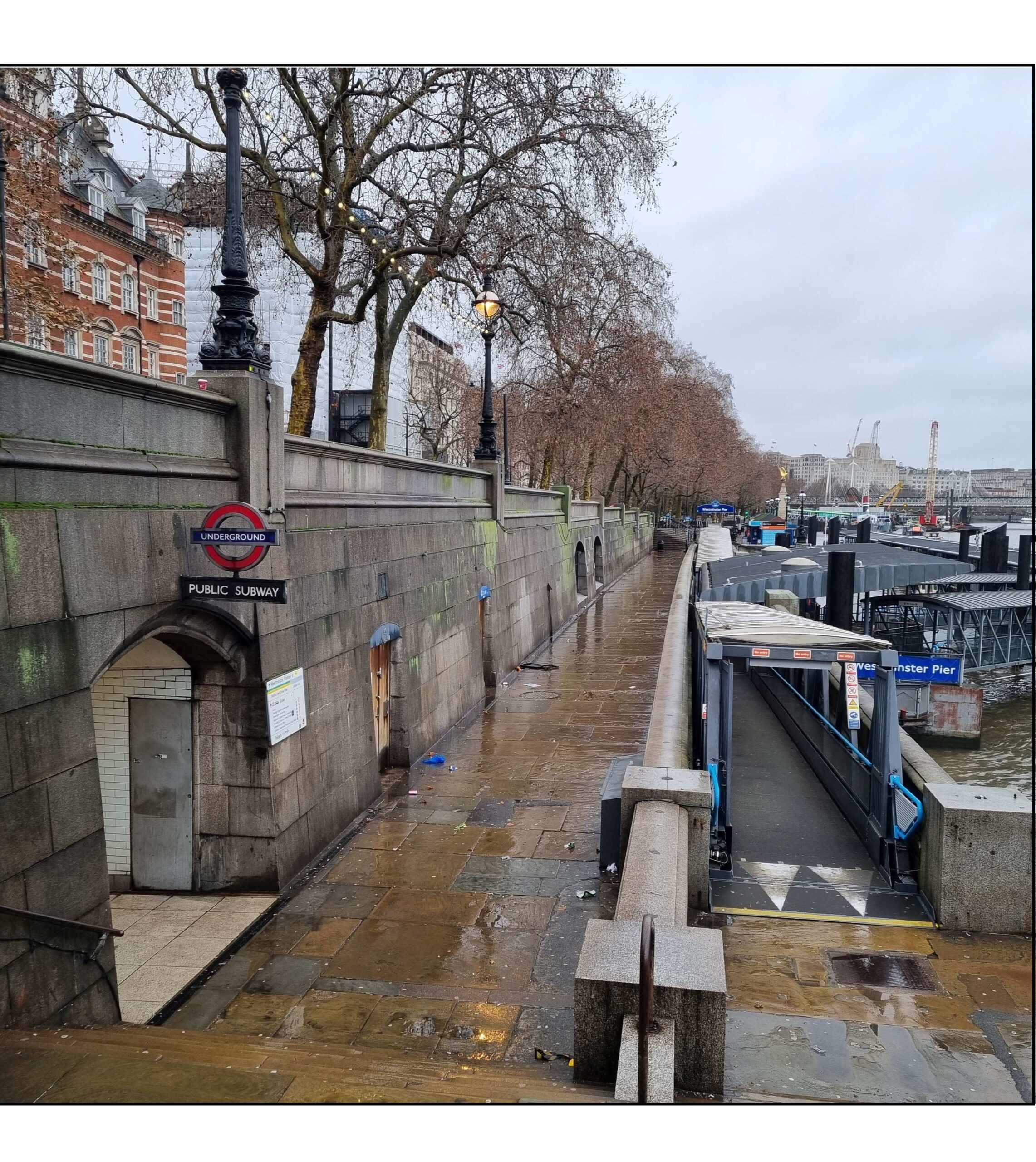
The bell also produced two problems. The first was moderate inconvenience: Many was the time a formal dinner, reception or private supper was interupted and MPs reluctantly rose to dash through the underground passage to the Commons. One tale, already a distant memory when recounted in Pearson’s Weekly in 1913, tells of an MP – possibly slightly inebriated – caught mid-supper when the familiar ringing was heard. Heroically leaving his food and more unfortunately his hat, he rushed off but absent-mindedly took a wrong turn in the subway, emerging onto Westminster Pier instead of New Palace Yard. His agitation attracted the attention of a policeman who, seeing he was hatless and thus improperly dressed, concluded that our man was about to throw himself in the Thames. He was promptly arrested and taken to New Scotland Yard. By the time matters were resolved, he’d both missed the vote and lost his supper.
← The subway exit to Westminster Pier in 2023.
The second problem was sabotage: The bell was linked to the Commons by private wire, vulnerable to those intent on mischief. One story goes that at a time of a Conservative government in the early years of the club, when a key division was about to be called, an unknown Liberal politician made fast and loose with wire cutters. The MPs at the club missed the vote; the Liberals won. A second incident at around the same time involved Irish MPs. Proposing an amendment to the annual Mutiny Bill, the Irish group indicated they would attempt a fillibuster – speaking in the Commons on the amendment to prevent a vote on the main bill. Conservative MPs retired to the club, had a fine meal and waited for a potentially very late division bell. However, the fillibuster was deliberately abandoned and a vote was called early. With the wire cut, possibly by nationalist MP Joseph Biggar, those returning from the club later were shocked to learn they had missed the vote. The government was defeated.
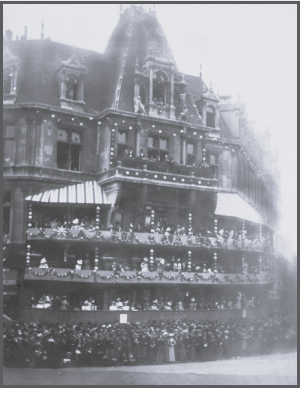
← The club during Queen Victoria’s diamond jubilee procession, 1897. The 2nd floor balcony holds the club’s dignitaries, while staff are on the pavement below.
The club would, from time to time, face problems unrelated to bells. In 1914, with Europe soon to be set ablaze by war, an overheated flue did the same for the club kitchen late one night. It took an hour to bring the flames under control. The third floor was gutted and part of the roof damaged, but there were no injuries – servants escaped after being roused by police. There were a great many needing to escape as the 1921 census lists twenty-four staying overnight: Night porter, engineer, stoker, plateman, valet, two wine waiters, three pages (one a 14-year-old orphan), housekeeper, linen maid, pastry maid, six housemaids, three stillroom maids and two chambermaids.
In 1917 news broke that the club was being requisitioned for the war effort and occupied by the Food Ministry. Three days later the club secretary announced a compromise had been reached and the club would not be requisitioned. No details were ever published, but I would hazard a guess that political connections played a part.
There goes the neighbourhood
From an early date, some of the club’s neighbours went all hip, cool and trendy. Not the plods – dear me no, they were so conservative they still had tack rooms for the horses’ saddles and tailors’ rooms for the repair of uniforms ripped by oiks. I refer to the small, dull block of offices between club and police, St Stephen’s House. An ideal base for lobbyists of all political hues, in the years through to the end of the First World War it seemed to be a hotbed of left-leaning agitation. An early occupant was the National Food Reform Society, a vegetarian group. The Men’s League for Women’s suffrage retained office space there in the early years of the 20th century as did the liberal Gladstone League and the Central Campaign Committee for the disestablishment of the Church of England in Wales. Not long after, politicians belonging to the Proportional Representation Society and the International Arbitration League joined them. Letters addressed from one office or another in the building appeared regularly in the pages of the liberal Westminster Gazette. Yet despite the onslaught, these trendy ideas failed to penetrate the Tory bastion next door; it was only in 1928 that a proposal was even put forward for women to be admitted as members. This despite the first woman MP to take her seat in the Commons, Nancy Astor, doing so in 1919 on the Conservative benches.
Redevelopment pencilled in for the 12th of Never.
Redevelopment of the club was first proposed in late 1939, the idea being that the club would take space in a larger replacement building. Soon after, perhaps to again avoid requisitioning, the club let the premises to the Ministry of Works. It was used as army accommodation, mainly by officers of the British Expeditionary Force. Then, in austere postwar London, there were no resources available for the proposed works, so the old clubhouse reopened in 1947. It promptly suffered another kitchen fire. Allegedly, sleeping MPs weren’t woken by the mass of firemen racing through the corridors.
Fire wasn’t its only problem. Membership was falling. Plans in 1958 by the Government to lease some of the club as parliamentary offices – the number of MPs far exceeded the rooms available in Parliament itself – would have brought in much-needed income. But then a grandiose scheme for the redevelopment of swathes of Whitehall, including the club and New Scotland Yard, were announced. And then rejected. In 1960 the stricken club sold its freehold to the Ministry of Works for £395,000. In 1962, with redevelopment seemingly imminent, it moved to smaller premises, a Georgian house on Queen Anne’s Gate. The bell went with it, but the extra distance from Parliament may have been its death knell; MPs could no longer reach the House from the club in time to vote and membership fell further. It had one last moment in the limelight, when David Cameron made his offer to Nick Clegg to form a coalition in 2010 there. This did nothing to improve its finances, and in 2013 it closed its doors for the last time.
Five years after the club had relocated, the Met also left the area, forced to move to an office block in Victoria. The Norman Shaw buildings were left empty, awaiting a date with the wreckers ball that never came. Their architecture came back into fashion in the nick of time and they were converted into more office space for MPs.
The former clubhouse and its immediate neighbours weren’t so lucky. Decrepid and less appreciated architecturally, they were never likely to be saved. More modest plans for redevelopment covering the club, St. Stephens House, Parliament Chambers and the station itself finally appeared in the early 1970s after an architectural competition. The winning design by Basil Spence’s nephew looked like an insipid cube; he got his winner’s cheque but the ex-clubhouse and its companions staggered on as plans for the Jubilee Line extension to run underneath the site provided yet another delay. Finally, new plans by Sir Michael Hopkins for a building above the reconstructed station, to include MPs’ offices and committee rooms, were unveiled in 1992. In 2000, just sixty-one years after redevelopment was first proposed, the stark Portcullis House was nearing completion. With the Norman Shaw Buildings also scheduled for refurbishment, parliamentarians should have been happy, but instead they moaned about the state of that quaint Victorian subway:
“I am depressed when I reach the tunnel leading from the Underground station to the Palace of Westminster: first, by the death-trap steps with which it is littered; secondly, by the builders’ detritus that is there; and, thirdly, by the garbage, the cans, the papers and everything else that collects there. In view of the fact that Portcullis House is costing £250 million … will the noble Lord use his undoubted charm and influence to see that the small amount of money that is needed is expended in order to supply a worthy entrance [to Parliament]”
Lord St. John of Fawsley, in the House of Lords, 6 April 2000
In Spence’s plan, the subway would have been replaced by a ‘travellator’. In the event, the passage survived. It was made step-free, and the pressing need for security meant the littering public were ejected, giving parliamentary passholders exclusive use. It was also linked directly to Portcullis House by escalator and had security gates fitted at the entrance from the station. Now it is even more ornate, having in 2015 acquired two monumental stone heraldic beasts, previously removed from St. Stephen’s Porch during restoration of the Parliament building.
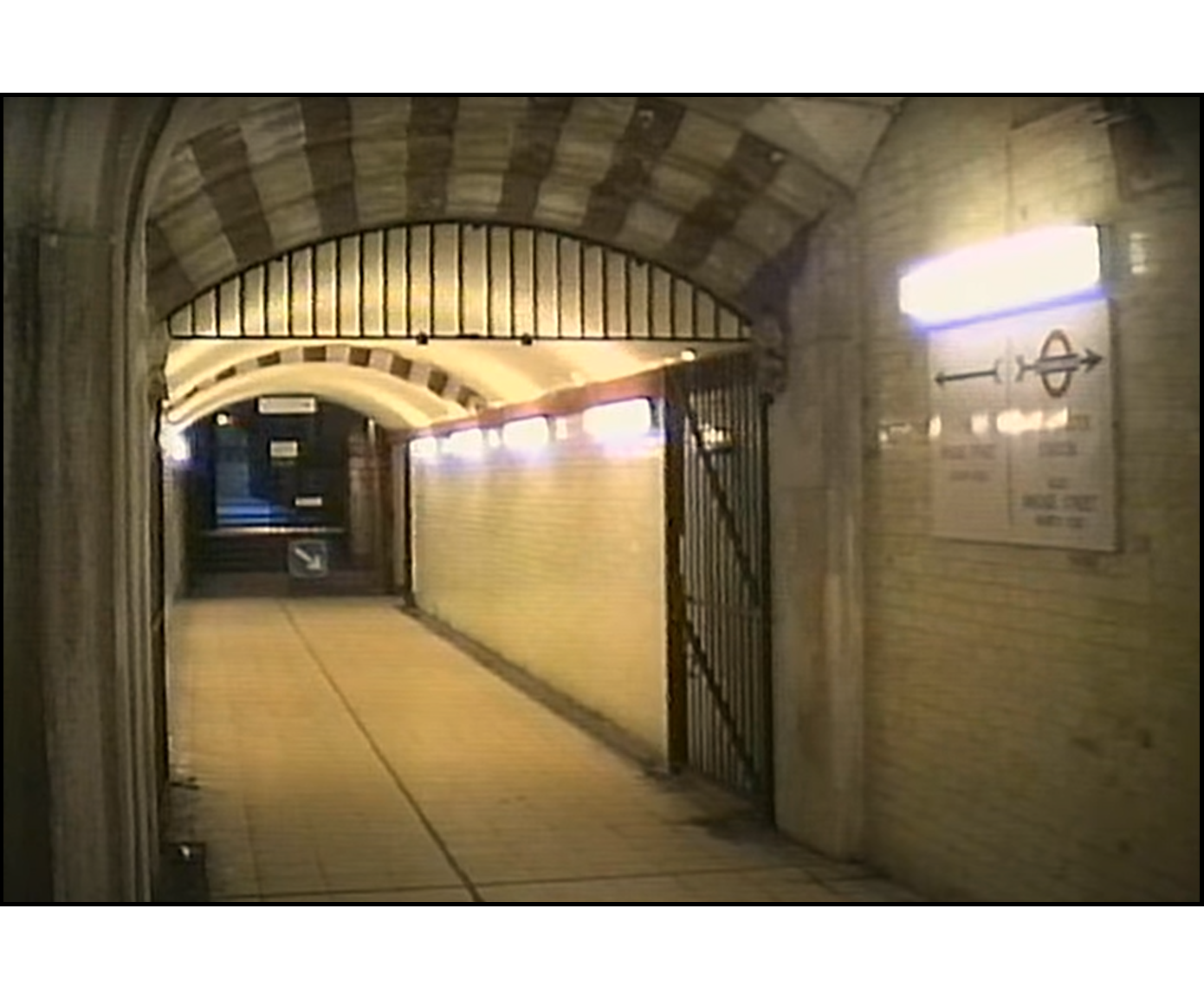
← An early 1990s view of the subway that made Lord St. John depressed. By this time the public had to exit to the Bridge Street south pavement where the blue arrow sign points in the distance; the steps into New Palace Yard beyond were gated and reserved for those with business in Parliament. To be honest, no existing image does the passage justice – just out of shot here is the stone archway and vaulted lobby, in a style consistent with the New Palace Yard colonnade beyond. Since the passage became private, photography has not been permitted.
Another change was the closure and filling-in of the public exit to Bridge Street south, replaced by a brand new subway from the station, excitingly named ‘Exit 3’ and surfacing a little closer to the river. It lasted just 17 years. In 2018, with security concerns greater than ever, there was a transfer of land from Transport for London to Parliament, and the new boundary in the tunnels is marked by a new security barrier. With this, Exit 3 became the property of Parliament, inaccessible to the public, and closed.
→ Another 1990s image, showing the Bridge Street south public entrance to the subway. Entrances to the tube seem permanent; in reality they are anything but.
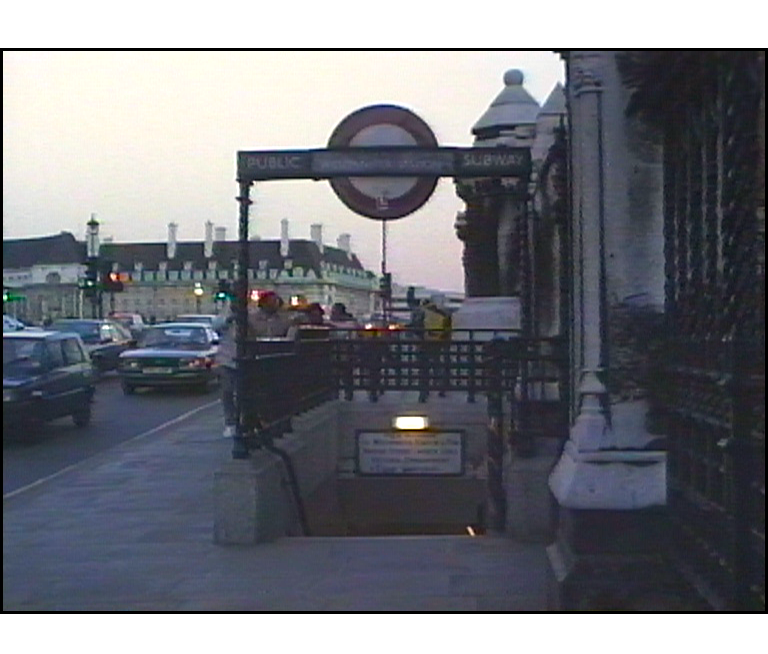
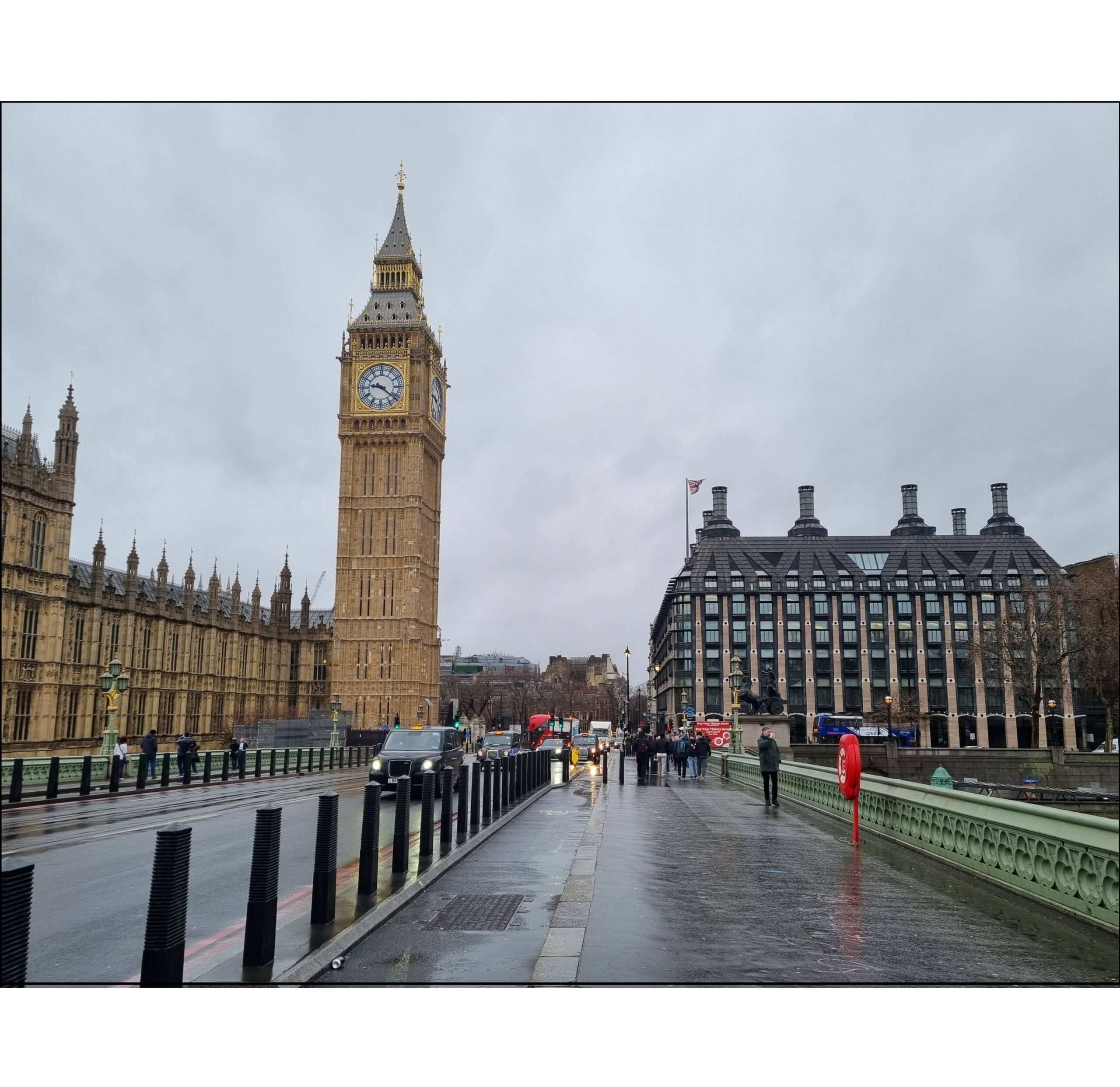
← The view from Westminster Bridge on a drizzly day in January 2023. The beautifully restored Elizabeth Tower and pink and grey Portcullis House speak of different eras. The St. Stephen’s Club’s tenure in its original clubhouse is now slipping from living memory.
→ The view of the Elizabeth Tower remains impaired by the club’s successor, Portcullis House. The former New Scotland Yard buildings are right (being renovated) and centre. All the buildings visible are now occupied by the parliamentary estate.
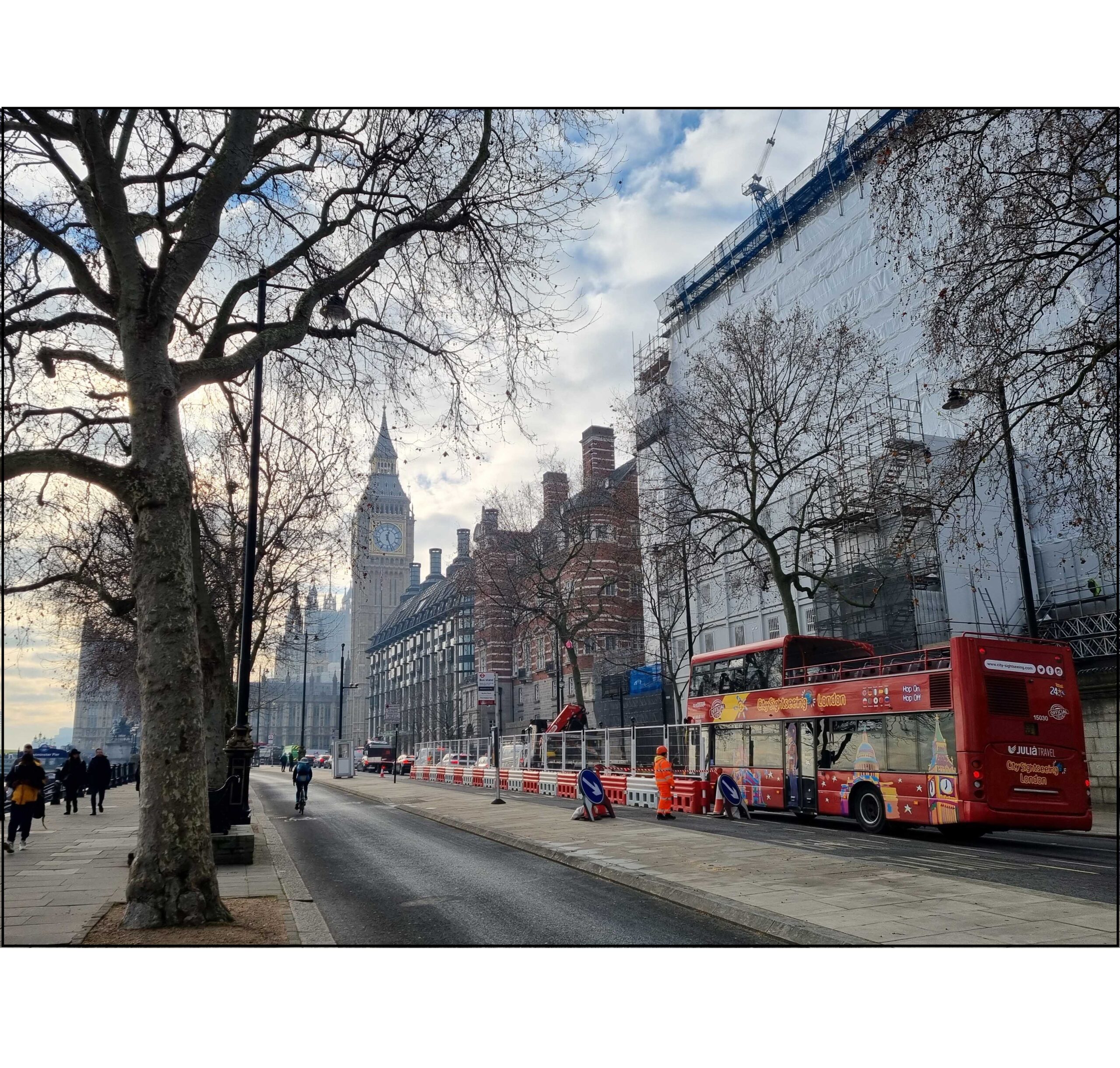
The scene now is rather more sober than it once was, or might have been. Fine architecture yes, but there was never an aria sung in anger, and both crime solving and the black museum have moved further up the Embankment, where the third New Scotland Yard now stands. The surviving tunnel is sometimes referred to as the “MP’s secret subway” despite being widely known about and used by rather more people than just MPs. If you listen carefully from the station, you might still hear the echoes of MPs dashing to vote through the subway – because they still do, from Portcullis House and the other buildings on that valuable riverside plot.

Notes:
Nearest Station: Westminster
Selected Bibliography:
Credits: